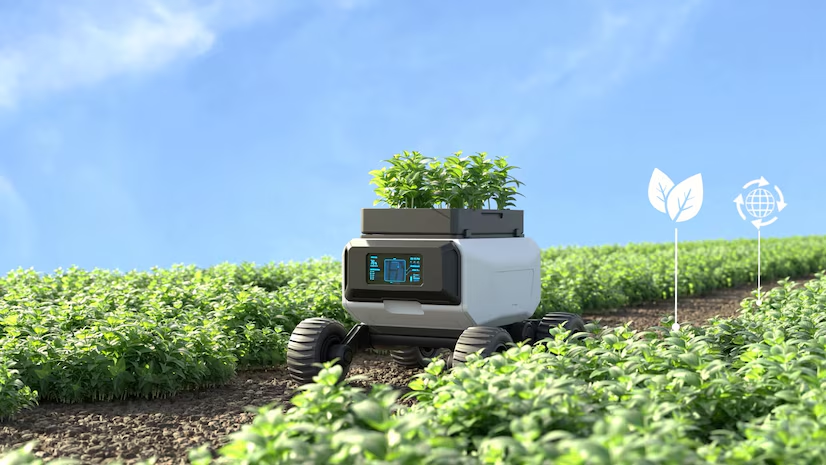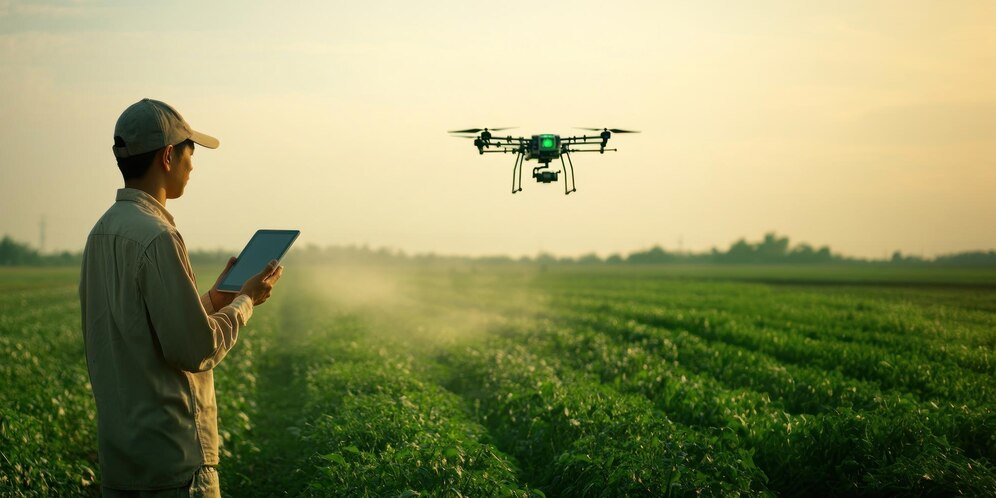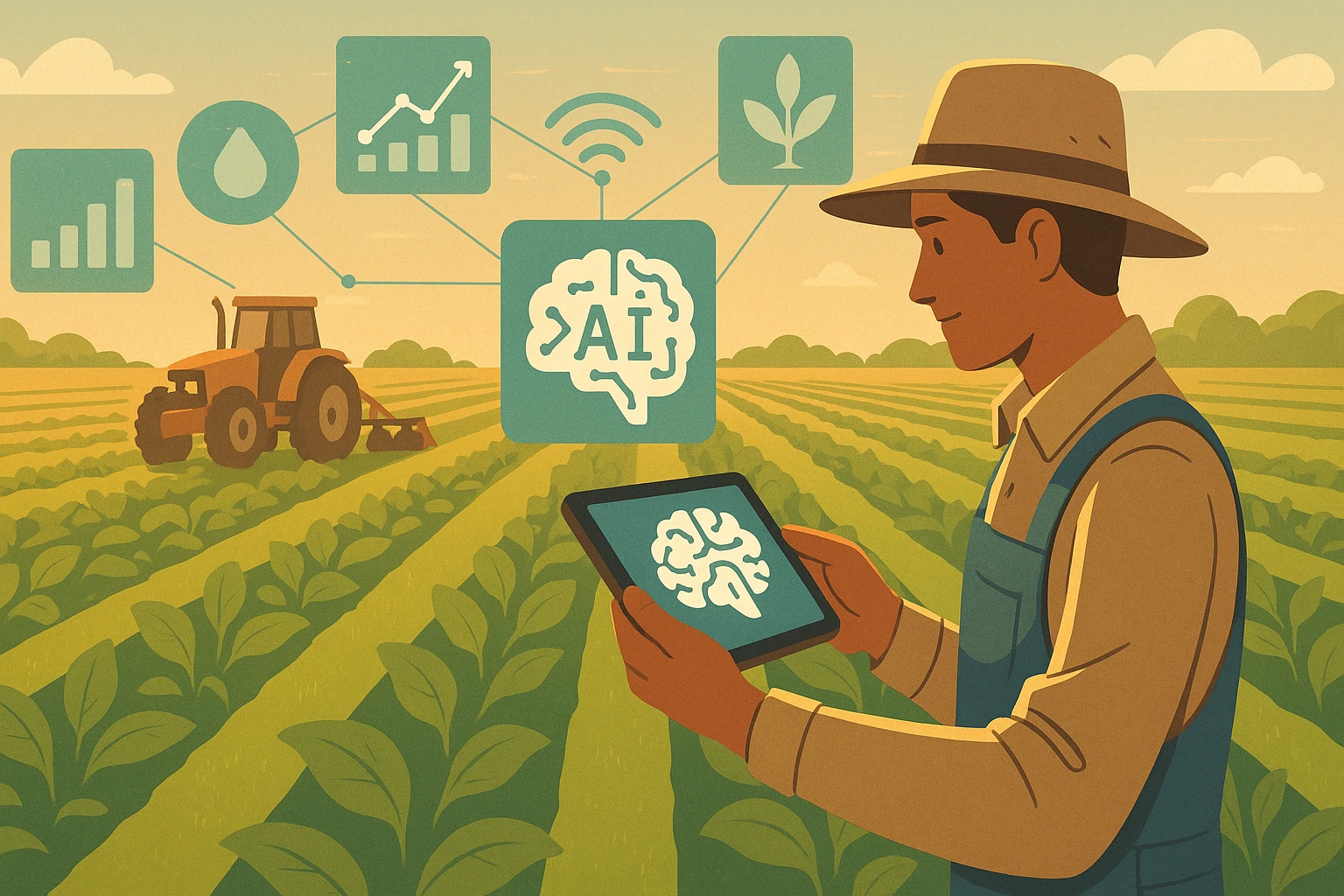Picture this: A farmer in Iowa checks her smartphone at dawn, receiving real-time updates about soil moisture levels, pest detection alerts, and precise weather forecasts for each section of her 500-acre farm. This isn’t science fiction—it’s the reality of modern agriculture technology powered by artificial intelligence.
The integration of AI in agriculture represents one of the most significant technological shifts in farming history. As global food demand soars and climate challenges intensify, smart farming solutions are becoming essential for sustainable food production.
Today’s farmers face unprecedented challenges: feeding a growing population, adapting to climate change, and managing resources efficiently. AI-driven agriculture offers powerful solutions that transform traditional farming into a data-driven, precision-based industry.
What Is AI in Agriculture and How Does It Work?
AI in agriculture refers to the application of machine learning, computer vision, and predictive analytics to optimize farming operations. These technologies analyze vast amounts of agricultural data to provide actionable insights for better decision-making.
At its core, agricultural AI combines sensors, drones, satellites, and sophisticated algorithms to monitor crops, predict yields, and automate farming tasks. This integration creates a comprehensive farm management system that operates with unprecedented precision.
The technology works by collecting data from multiple sources—weather stations, soil sensors, satellite imagery, and historical yield records. Machine learning algorithms then process this information to identify patterns, predict outcomes, and recommend optimal farming strategies.
Modern precision farming relies on this continuous data flow to make real-time adjustments. Whether it’s adjusting irrigation schedules or detecting early signs of disease, AI enables farmers to respond proactively rather than reactively.
How Is AI Revolutionizing Traditional Farming Methods?
The transformation from traditional to AI-powered farming represents a fundamental shift in agricultural practices. Where farmers once relied on experience and intuition, they now have access to data-driven insights that enhance every aspect of crop production.
Precision agriculture has replaced the one-size-fits-all approach. Instead of treating entire fields uniformly, farmers can now customize treatments for specific zones based on soil conditions, moisture levels, and crop health indicators.
This revolution extends beyond crop management. AI-powered systems optimize equipment usage, reduce fuel consumption, and minimize chemical applications. The result is more sustainable farming that produces higher yields with fewer resources.
The Role of Machine Learning in Crop Management

Machine learning algorithms excel at pattern recognition, making them ideal for identifying crop diseases, pest infestations, and nutrient deficiencies before they become visible to the human eye. These systems analyze thousands of plant images to detect subtle changes in leaf color, texture, or growth patterns.
Predictive models help farmers anticipate problems weeks in advance. By analyzing historical data alongside current conditions, AI can forecast disease outbreaks, allowing preventive treatments that save entire harvests.
The technology also optimizes planting decisions. Machine learning considers soil conditions, weather patterns, and market prices to recommend the best crops for each field and the optimal planting times.
Smart Irrigation Systems and Water Conservation
Water scarcity affects agriculture worldwide, making efficient irrigation crucial for sustainable farming. AI-driven irrigation systems use soil moisture sensors, weather forecasts, and crop water requirements to deliver precise amounts of water exactly when needed.
These smart systems reduce water usage by up to 30% while improving crop yields. They automatically adjust irrigation schedules based on rainfall predictions, preventing both overwatering and drought stress.
Advanced systems even account for different water needs across a single field. Variable rate irrigation technology ensures that sandy areas receive more water while clay-rich zones get less, optimizing water distribution throughout the farm.
What Are the Key Benefits of AI in Agriculture?
The adoption of agriculture technology powered by AI delivers transformative benefits across multiple dimensions of farming operations. These advantages extend from individual farms to global food security.
Increased Crop Yields and Productivity
AI-driven agriculture consistently demonstrates yield improvements of 15-30% compared to traditional methods. By optimizing every variable from seed selection to harvest timing, farmers maximize their land’s productive potential.
Predictive analytics help farmers make better decisions about crop rotation, fertilizer application, and pest management. This data-driven approach eliminates guesswork and ensures that crops receive exactly what they need for optimal growth.
The technology also identifies underperforming areas within fields, allowing targeted interventions that bring these zones up to full productivity. This granular approach transforms previously marginal land into profitable acreage.
Cost Reduction and Resource Optimization
Smart farming significantly reduces operational costs through efficient resource utilization. AI systems minimize waste by applying fertilizers, pesticides, and water only where needed, cutting input costs by 20-40%.
Automated machinery guided by AI reduces labor requirements and improves operational efficiency. Tractors equipped with GPS and computer vision can work around the clock with minimal human supervision.
Energy consumption drops as AI optimizes equipment routes and operational timing. By analyzing field conditions and weather patterns, the system schedules activities during optimal conditions, reducing fuel usage and equipment wear.
Environmental Sustainability
Precision farming dramatically reduces agriculture’s environmental footprint. By applying chemicals only where necessary, AI systems minimize runoff and protect water quality in surrounding ecosystems.
Carbon emissions decrease through optimized machinery use and reduced chemical production. Some AI platforms even help farmers implement carbon sequestration strategies, turning farms into carbon sinks.
Biodiversity benefits from reduced chemical usage and more targeted pest control methods. AI can identify beneficial insects and recommend biological control methods instead of broad-spectrum pesticides.
Real-World Applications of AI in Modern Farming
Drone Technology for Crop Monitoring
Agricultural drones equipped with multispectral cameras provide unprecedented visibility into crop health. These aerial platforms capture detailed imagery that reveals stress patterns invisible to the naked eye.
Farmers use drone data to create prescription maps for variable-rate applications. By identifying areas needing attention, they can address problems before they spread, saving both crops and resources.
Modern drones operate autonomously, following pre-programmed flight paths to ensure complete field coverage. AI algorithms process the captured images in real-time, delivering actionable insights within hours.
Robotic Harvesting and Automation
Harvesting robots represent one of the most visible applications of AI in agriculture. These machines use computer vision to identify ripe produce and gentle manipulators to harvest delicate crops without damage.
Companies like Abundant Robotics have developed apple-picking robots that match human harvesting speeds while working 24/7. Similar systems exist for strawberries, tomatoes, and other high-value crops.
Beyond harvesting, agricultural robots perform tasks like weeding, pruning, and thinning. These automated systems address labor shortages while improving consistency and reducing crop damage.
AI-Powered Pest and Disease Detection

Early detection of pests and diseases can mean the difference between minor treatment and total crop loss. AI systems analyze images from smartphones, drones, or fixed cameras to identify problems at their earliest stages.
Machine learning models trained on millions of images can diagnose plant diseases with 90%+ accuracy. Farmers simply photograph affected plants and receive instant identification along with treatment recommendations.
These systems also predict disease outbreaks by analyzing weather conditions, crop stages, and historical patterns. This predictive capability allows preventive treatments that are both more effective and less environmentally impactful.
Predictive Analytics for Weather and Yield Forecasting
Accurate weather prediction is crucial for farming decisions. AI systems combine local sensor data with satellite observations and historical patterns to provide hyper-local forecasts specific to individual fields.
Yield prediction models help farmers plan harvest logistics and negotiate contracts. By analyzing crop conditions throughout the growing season, AI provides increasingly accurate yield estimates as harvest approaches.
These forecasts also inform financial decisions. Banks and insurance companies use AI-generated predictions to assess risk and provide better terms to farmers demonstrating data-driven management practices.
What Challenges Does AI Face in Agriculture?
High Implementation Costs
The initial investment in AI technology can be substantial, particularly for small and medium-sized farms. Hardware costs for sensors, drones, and automated equipment often reach hundreds of thousands of dollars.
Software licensing and data management systems add ongoing expenses. Many farmers struggle to justify these costs without clear evidence of return on investment.
However, costs are declining as technology matures. Cooperative ownership models and equipment-sharing arrangements make AI tools accessible to smaller operations.
Technical Skills and Training Requirements
Implementing AI in agriculture requires new skills that many farmers haven’t traditionally needed. Understanding data analytics, maintaining sensors, and interpreting AI recommendations demand ongoing education.
Rural areas often lack technical support infrastructure, making troubleshooting difficult. When systems fail during critical periods, delays in repairs can result in significant losses.
Agricultural extension services are adapting to provide AI-focused training. Universities offer online courses, and equipment manufacturers provide comprehensive support programs.
Data Privacy and Security Concerns
Farm data has become valuable, raising concerns about ownership and usage rights. Farmers worry about sharing sensitive information about yields, practices, and land quality with technology companies.
Cybersecurity threats pose risks to automated farming systems. A successful attack on irrigation or harvesting systems could cause devastating losses.
Clear data governance frameworks are emerging to address these concerns. Farmers increasingly demand transparency about data usage and the right to control their information.
The Future of AI-Driven Agriculture
Emerging Technologies and Innovations
Quantum computing promises to revolutionize agricultural modeling, enabling climate predictions and crop simulations of unprecedented accuracy. These advances will further improve planning and risk management.
Synthetic biology combined with AI accelerates crop breeding programs. Machine learning identifies genetic markers for desired traits, reducing development time for climate-adapted varieties.
Blockchain integration ensures supply chain transparency while securing farm data. This combination of technologies creates trusted networks for sustainable agriculture certification.
Integration with IoT and 5G Networks
The rollout of 5G networks enables real-time communication between thousands of farm sensors. This connectivity allows instant responses to changing conditions across vast agricultural areas.
Edge computing brings AI processing directly to farm equipment, reducing latency and enabling autonomous operations even in areas with limited connectivity.
Internet of Things (IoT) sensors become increasingly sophisticated, monitoring everything from individual plant health to microscopic soil organisms. This data richness enables ever-more-precise farming decisions.
Global Impact on Food Security
AI-driven agriculture plays a crucial role in feeding the projected 10 billion people by 2050. By increasing yields while reducing resource usage, these technologies make sustainable intensification possible.
Developing nations benefit from leapfrogging traditional agricultural development stages. Mobile-based AI tools bring precision farming capabilities to smallholder farmers worldwide.
Climate adaptation becomes more manageable as AI helps farmers adjust to changing conditions. Crop recommendations, planting schedules, and water management strategies evolve in real-time as patterns shift.
How to Get Started with AI in Agriculture
Beginning the journey toward smart farming doesn’t require implementing every technology at once. Start with one area where your farm faces the biggest challenges or opportunities.
Soil testing and variable-rate fertilization often provide the quickest return on investment. These entry-level precision agriculture tools demonstrate AI’s value while building technical confidence.
Partner with local agricultural technology providers who understand regional conditions. Many offer trial programs or seasonal rentals that reduce initial investment risks.
Join farmer networks focused on precision agriculture. Learning from peers’ experiences accelerates your own adoption curve while avoiding common pitfalls.
Consider starting with smartphone-based tools for disease identification or weather monitoring. These low-cost applications introduce AI concepts without major infrastructure changes.
Frequently Asked Questions
What is the average cost of implementing AI in a small farm?
Entry-level AI implementations for small farms typically range from $10,000 to $50,000, including basic sensors, software subscriptions, and training. Costs vary based on farm size and chosen technologies.
How long does it take to see ROI from AI farming technologies?
Most farmers report positive ROI within 2-3 growing seasons. Immediate benefits include reduced input costs, while yield improvements become apparent over multiple seasons.
Can AI in agriculture work without internet connectivity?
Yes, many AI systems operate offline using edge computing. They sync data when connectivity is available but continue functioning autonomously in remote areas.
What crops benefit most from AI technology?
High-value crops like fruits, vegetables, and nuts show the greatest ROI from AI implementation. However, grain farmers also benefit significantly from precision agriculture technologies.
Is AI in agriculture suitable for organic farming?
Absolutely. AI helps organic farmers optimize biological pest control, improve crop rotation planning, and reduce manual weeding through targeted mechanical intervention.
How accurate are AI predictions for crop yields?
Modern AI systems achieve 85-95% accuracy in yield predictions when provided with sufficient historical data and current season monitoring.
What technical skills do farmers need to use AI tools?
Basic smartphone and computer skills suffice for many AI applications. Most systems feature user-friendly interfaces designed for non-technical users.
Can AI help with livestock farming?
Yes, AI monitors animal health, optimizes feeding schedules, and predicts breeding outcomes. Computer vision systems detect early signs of illness in cattle, pigs, and poultry.
How does AI in agriculture address climate change?
AI optimizes resource use, reduces emissions, and helps farmers adapt to changing weather patterns through improved prediction and crop selection.
What data security measures protect farm information?
Modern agricultural AI platforms use encryption, secure cloud storage, and strict access controls. Many offer data ownership guarantees and transparent usage policies.
Are government subsidies available for AI adoption in farming?
Many countries offer grants, tax incentives, or low-interest loans for precision agriculture adoption. Check with local agricultural departments for specific programs.
How do AI systems handle crop diversity and rotation?
Advanced AI platforms model complex rotation schemes and polyculture systems. They optimize plant combinations for soil health, pest management, and economic returns.
Conclusion
The integration of AI in agriculture represents more than technological advancement—it’s a fundamental transformation in how we produce food. As these smart farming systems become more accessible and affordable, they promise to address critical challenges in food security, environmental sustainability, and farm profitability.
The journey toward AI-driven agriculture requires investment, learning, and adaptation. However, the benefits—increased yields, reduced costs, and environmental protection—make this transformation not just worthwhile but essential for farming’s future.
Whether you’re a small family farmer or managing thousands of acres, AI technologies offer tools to improve your operation. Start small, learn continuously, and join the agricultural revolution that’s feeding the world more sustainably than ever before.
